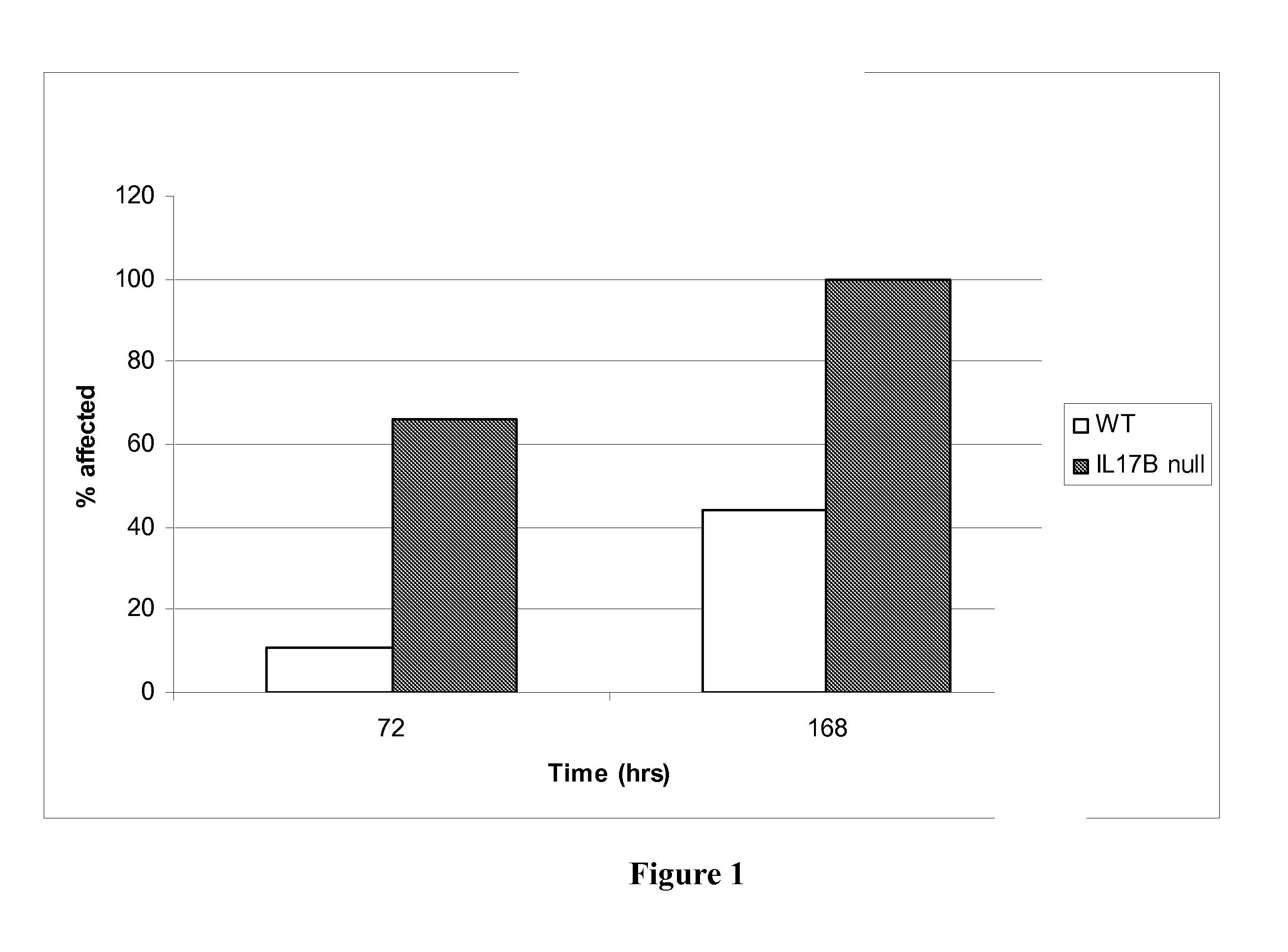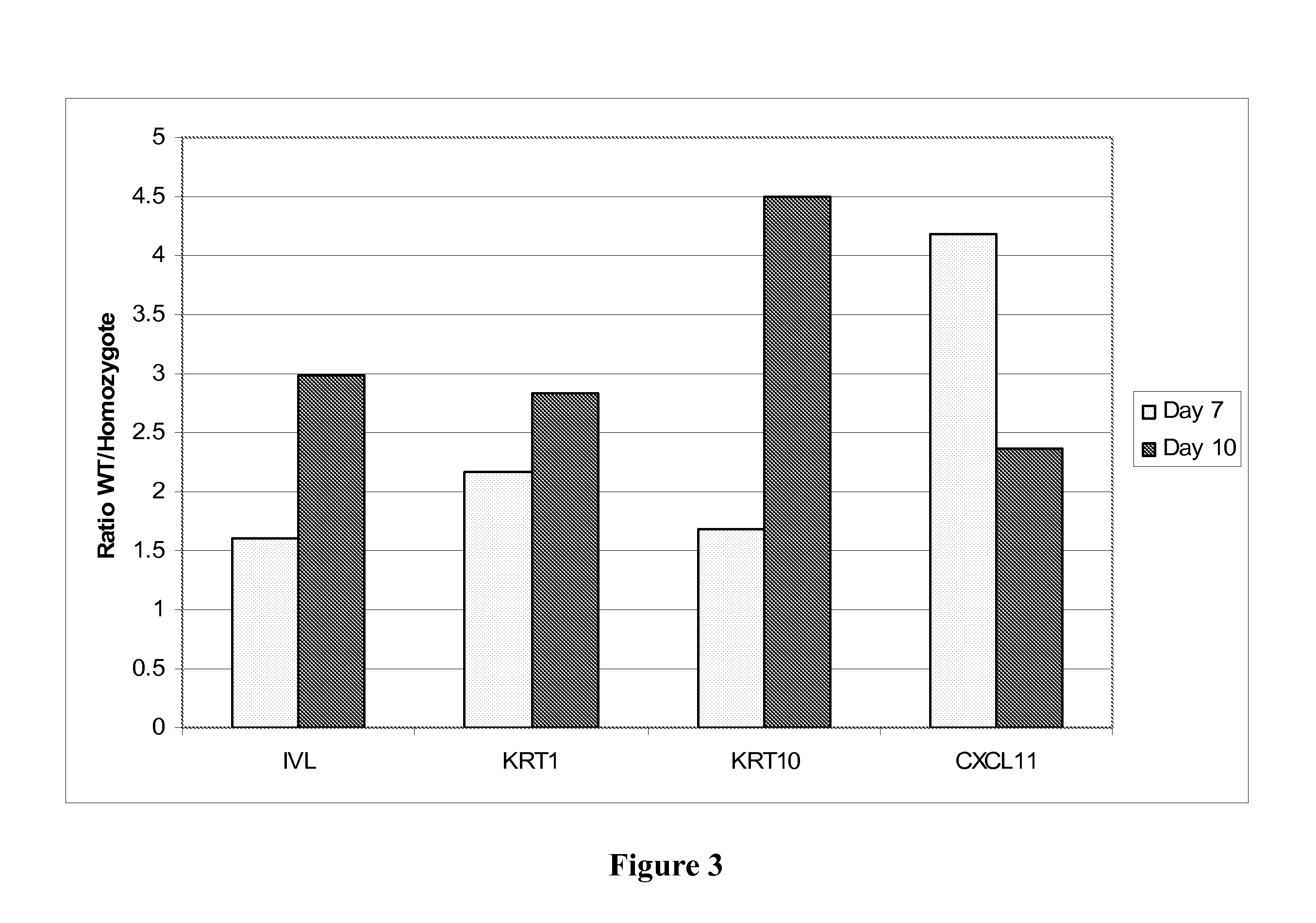Treatment of wounds using il-17b
- Summary
- Abstract
- Description
- Claims
- Application Information
AI Technical Summary
Benefits of technology
Problems solved by technology
Method used
Image
Examples
example 1
[0054] Wild type or IL-B (zcyto7) homozygous knockout mice were anesthetized with isoflourane and the dorsum shaved and depilated. After 24 hrs mice were anesthetized with isoflourane, and the dorsum cleaned with Povidone-Iodine and Isopropyl alcohol pads. Animals received either one or two full thickness wounds of 0.5 cm2 or 1 cm2; these were induced on either flank by the surgical removal of a piece of full thickness dorsal skin. The wound area was then bandaged with a Johnson & Johnson Bioocclusive dressing and these dressings were removed at three days. Animals were examined daily and the size and physical appearance of the wounds assessed. At various time points a 1 cm2 area of skin surrounding the 0.5 cm2 wound was surgically removed and these samples were processed for histological evaluation by formalin fixation or flash frozen in liquid nitrogen for RNA isolation. At various time points, final size and appearance observations were made. The animals were then euthanized and ...
example 2
[0057] The observational experiments of Example 1 were supported by RNA-based expression measurements. Using a multiplex approach, the expression of 293 genes in normal and wounded tissue from wild type and knockout mice were examined. Multiplex gene expression assays of murine skin tissue samples were performed essentially as described by Yang et al. (Yang et al., “BADGE, BeadsArray for the Detection of Gene Expression, a High-Throughput Diagnostic Bioassay”, GenomeResearch, 11:1888-1898 (2001)). Total RNA was prepared using a standard phenol:chloroform extraction protocol for tissues and converted to antisense RNA (aRNA) using Ambion MessageAmp aRNA Amplification kits (Ambion, Inc. Austin, Tex.), incorporating biotinylated UTP and CTP (PerkinElmer Life Sciences, Boston, Mass.). aRNA was quantified by absorbance at 260 nm.
[0058] Gene specific sense oligonucleotides (25-mers) were synthesized with 5′-amino uni-linkers and coupled to Luminex xMAP carboxylated microspheres according ...
example 3
[0063] The mouse model of cutaneous leishmaniasis was performed essentially as described in “Animal models for the analysis of immune responses to leishmaniasis,” in Current Protocols in Immunology David Sacks and Peter Melby, Chapter 19.2.1-19.2.20 (1998). This model was used to investigate the role of zcyto7 in wound healing.
[0064] Historically, susceptibility to cutaneous L. major infection has been associated with chronic and progressive swelling at the site of infection, development of Th2 responses (low IFN-g:IL-4 production ratio; high levels of IL-4 produced) and production of high levels of IL-10, elevated levels of serum IgE and systemic dissemination of L. major. Resistance to cutaneous L. major infection has been associated with acute swelling at the site of infection that ultimately heals, development of Th1 responses (high IFN-g:IL-4 production ratio), absence of serum IgE and containment of L. major to the site of infection.
[0065] Recent publications have shown that...
PUM
| Property | Measurement | Unit |
|---|---|---|
| Composition | aaaaa | aaaaa |
| Mechanical properties | aaaaa | aaaaa |
| Thermal properties | aaaaa | aaaaa |
Abstract
Description
Claims
Application Information
 Login to View More
Login to View More - R&D
- Intellectual Property
- Life Sciences
- Materials
- Tech Scout
- Unparalleled Data Quality
- Higher Quality Content
- 60% Fewer Hallucinations
Browse by: Latest US Patents, China's latest patents, Technical Efficacy Thesaurus, Application Domain, Technology Topic, Popular Technical Reports.
© 2025 PatSnap. All rights reserved.Legal|Privacy policy|Modern Slavery Act Transparency Statement|Sitemap|About US| Contact US: help@patsnap.com



